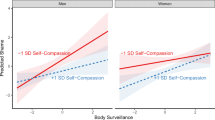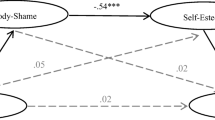Abstract
Benevolent sexism has been shown to have negative consequences for women. In the present study, we investigated whether there were differences in reports of body self-perceptions between 93 college women in the southeastern United States who either witnessed or did not witness a staged act of benevolent sexism. Because we believed that benevolent sexism could make beauty norms more salient, we hypothesized that women who witnessed benevolent sexism would report higher levels of self-objectification, body surveillance, and body shame. Women who witnessed benevolent sexism did report higher levels of surveillance and shame, constructs associated with self-objectification, but not higher general levels of self-objectification. This research provides more evidence of the negative effects benevolent sexism has on women.
Similar content being viewed by others
References
American Psychological Association, Task Force on the Sexualization of Girls (2007). Report of the APA Task Force on the Sexualization of Girls. Washington, DC: American Psychological Association. Retrieved from http://www.apa.org/pi/wpo/sexualization.html
Barreto, M., & Ellemers, N. (2005). The burden of benevolent sexism: How it contributes to the maintenance of gender inequalities. European Journal of Social Psychology, 35, 633–642.
Byrne, D., London, O., & Reeves, K. (2006). The effects of physical attractiveness, sex, and attitude similarity on interaction attraction. Journal of Personality, 36, 259–271.
Calogero, R. (2004). A test of objectification theory: The effect of the male gaze on appearance concerns in college women. Psychology of Women Quarterly, 28, 16–21.
Dardenne, B., Dumont, M., & Bollier, T. (2007). Insidious dangers of benevolent sexism: Consequences for women’s performance. Journal of Personality and Social Psychology, 93, 764–779.
Daubenmier, J. J. (2005). The relationship of yoga, body awareness, and body responsiveness to self-objectification and disordered eating. Psychology of Women Quarterly, 29, 207–219.
Deutsch, M., & Gerard, H. G. (1955). A study of normative and informational social influence upon individual judgment. Journal of Abnormal and Social Psychology, 51, 629–636.
Forbes, G. B., Collinsworth, L. L., Jobe, R. L., Braun, K. D., & Wise, L. M. (2007). Sexism, hostility toward women, and endorsement of beauty ideals and practices: Are beauty ideals associated with oppressive beliefs? Sex Roles, 56, 265–273.
Franzoi, S. L. (2001). Is female body esteem shaped by benevolent sexism? Sex Roles, 44, 177–188.
Fredrickson, B. L., & Roberts, T.-A. (1997). Objectification theory: Toward understanding women’s lived experiences and mental health risks. Psychology of Women Quarterly, 21, 173–206.
Fredrickson, B. L., Roberts, T.-A., Noll, S. M., Quinn, D. M., & Twenge, J. M. (1998). That swimsuit becomes you: Sex differences in self-objectification, restrained eating, and math performance. Journal of Personality and Social Psychology, 75, 269–284.
Glick, P., & Fiske, S. T. (1996). The ambivalent sexism inventory: Differentiating hostile and benevolent sexism. Journal of Personality and Social Psychology, 70, 491–512.
Glick, P., & Fiske, S. T. (2001). An ambivalent alliance: Hostile and benevolent sexism as complimentary justifications for gender inequality. American Psychologist, 56, 109–118.
Glick, P., Fiske, S. T., Mladinic, A., Sainz, J. L., Abrams, D., Masser, B., et al. (2000). Beyond prejudice as simple antipathy: Hostile and benevolent sexism across cultures. Journal of Personality and Social Psychology, 79, 763–775.
Hurt, M. M., Nelson, J. A., Turner, D. L., Haines, M. E., Ramsey, L. R., Erchull, M. J., et al. (2007). Feminism: What is it good for? Feminine norms and objectification as the link between feminist identity and clinically relevant outcomes. Sex Roles, 57, 355–363.
Johnston-Robledo, I., & Fred, V. (2008). Self-objectification and lower income pregnant women’s breastfeeding attitudes. Journal of Applied Social Psychology, 38, 1–21.
Johnston-Robledo, I., Sheffield, K., Voight, J., & Wilcox-Constantine, J. (2007). Reproductive shame: Self-objectification and young women’s attitude towards their reproductive functioning. Women & Health, 46, 25–36.
Kelley, H. H. (1955). The two functions of reference groups. In G. E. Swanson, T. M. Newcomb, & E. L. Hartley (Eds.), Readings in social psychology (2nd ed., pp. 410–414). New York: Henry Holt.
Kilianski, S. E., & Rudman, L. A. (1998). Wanting it both ways: Do women approve of benevolent sexism? Sex Roles, 39, 333–352.
Mahalik, J. R., Morray, E. B., Coonerty-Femiano, A., Ludlow, L. H., Slattery, S. M., & Smiler, A. (2005). Development of the conformity to feminine norms inventory. Sex Roles, 52, 417–435.
McKinley, N. M., & Hyde, J. S. (1996). The objectified body consciousness scale: Development and validation. Psychology of Women Quarterly, 20, 181–215.
Noll, S. M., & Fredrickson, B. L. (1998). A mediational model linking self-objectification, body shame, and disorder eating. Psychology of Women Quarterly, 22, 623–636.
Roberts, T.-A. (2004). Female trouble: The menstrual self-evaluation scale and women’s self-objectification. Psychology of Women Quarterly, 22, 22–26.
Rose, E., & Felton, W. (1955). Experimental histories of culture. American Sociological Review, 20, 383–392.
Sherif, M. (1936). The psychology of social norms. Oxford: Harper.
Sibley, C. G., & Wilson, M. S. (2004). Differentiating hostile and benevolent sexist attitudes toward positive and negative sexual female subtypes. Sex Roles, 51, 687–696.
Smolak, L., & Murnen, S. K. (2008). Drive for leanness: Assessment and relationship to gender, gender role and objectification. Body Image, 5, 251–260.
World Health Organization (n.d.). BMI classification. Retrieved from http://apps.who.int/bmi/index.jsp?introPage=intro_3.html
Author information
Authors and Affiliations
Corresponding author
Rights and permissions
About this article
Cite this article
Shepherd, M., Erchull, M.J., Rosner, A. et al. “I’ll Get That for You”: The Relationship Between Benevolent Sexism and Body Self-Perceptions. Sex Roles 64, 1–8 (2011). https://doi.org/10.1007/s11199-010-9859-2
Published:
Issue Date:
DOI: https://doi.org/10.1007/s11199-010-9859-2




